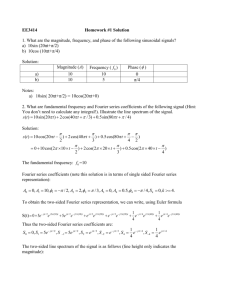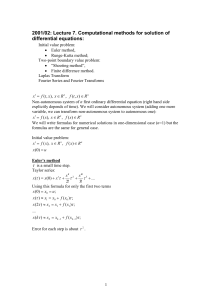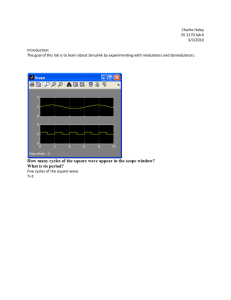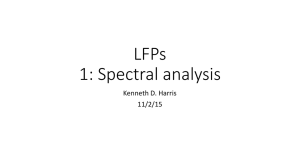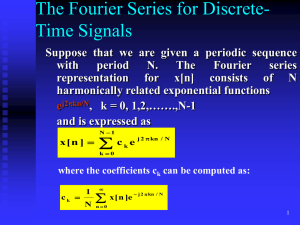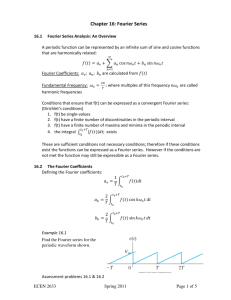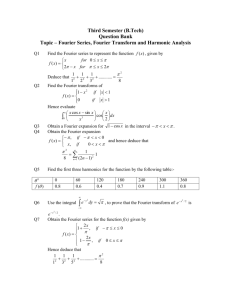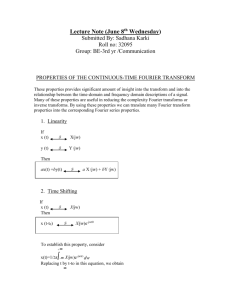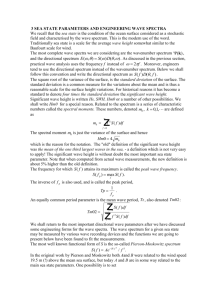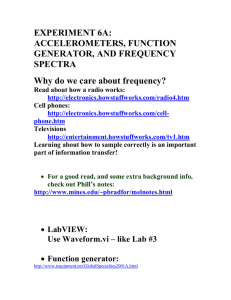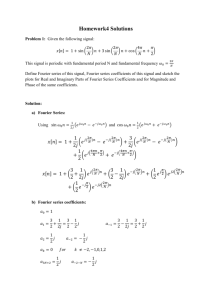PPT
advertisement
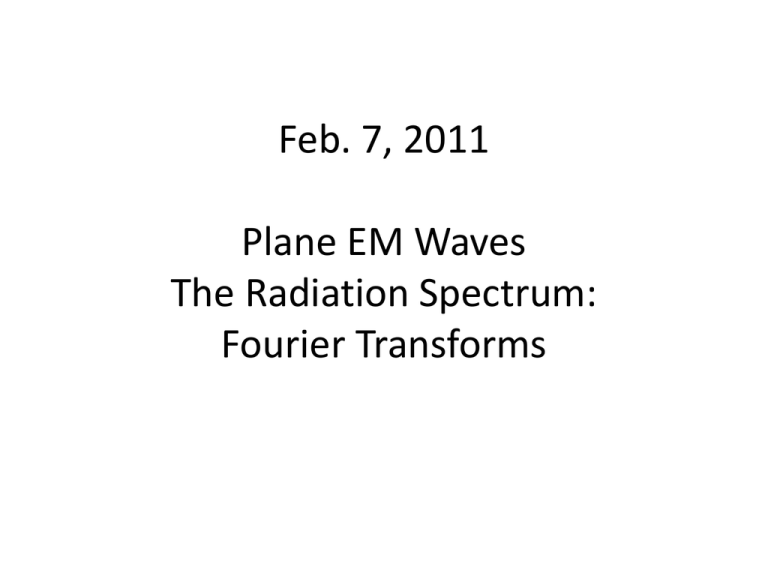
Feb. 7, 2011 Plane EM Waves The Radiation Spectrum: Fourier Transforms Vector Wave Equations for E and B: 2 1E 2 E 2 2 0 c t 2 1B 2 B 2 2 0 c t For solutions to the 3-Dimensional wave equation, use complex notation i ( k r t ) ˆ E a E e 1 0 i ( k r t ) ˆ B a B e 2 0 where ˆ1,a ˆ2 are a unit vecto rs r(x,y,z) Cartesian position ector v E complex constants 0,B 0 are ˆkn ˆ wave k vector angular frequency Before we go further, let’s review complex numbers imaginary Argand Diagram x+iy y r z x Complex number Complex conjugate z x iy z x iy i 1 x = real part of z y = imaginary part of z real In polar coordinates x r cos y r si z x iy r (co i si ) n so The Euler Formula e cos i sin i implies z re r cos ir sin i r = magnitude of z θ = phase angle of z Re(z) = real part of z = rcosθ Im(z) = imaginary part of z = r sinθ Since exponentials are so easy to integrate and differentiate, it is convenient to describe waves as ( z , t ) Ae i ( kz t ) Where A is a real constant To get the physically meaningful quantity, which must be a real number, one solves the wave equation and then takes the REAL part of the solution. This is OK, since the wave equation is linear, so that the real part of Ψ and its imaginary part are each separately solutions. So for example you can write i ( k t ) z E Re E e 0 Re alimaginar where E E i E i a s com cto 0 0 0 then r r real r imaginary E Re E 0 iE 0 cos(kz t) isin(kz t) r real r imaginary E 0 cos(kz t) E 0 sin(kz t) vector vector Solution to the wave equations: i ( k r t ) ˆ E a E e 1 0 i ( k r t ) ˆ B a B e 2 0 E , B are comp scal 0 0 k wave vecto k n The waves travel in direction n or k k surfaces of constant phase travel with time in direction i ( k r t ) i ( k r t ) ˆ ˆ B a B e E a E e 2 0 1 0 These must also satisfy Maxwell’s Equations r r i( k r t ) ˆ E 0 a1 E 0e 0 Recall the definition of the divergence: E E E y x E z x y z ˆ E ( a ) E e x E x ˆ ( a )E k ie x i ( k r t ) 1 x0 i ( k r t ) 1 x 0x So E 0 ˆ i k a E 0 1 0 i ( k r t ) ˆ E a E e 1 0 i ( k r t ) ˆ B a B e 2 0 “Can show” the other equations are ˆ ˆ k a B 0 i k a E 0 i 2 0 1 0 i i ˆ ˆ i k a B a E ˆ ˆ i k a E a B 2 0 1 0 10 20 c c ˆ ˆ Since k a 0 and k a 0 1 2 ˆ ˆ both a (that is E ) and a (that is B ) 1 2 are transverse to the direction of propag n, k i ( k r t ) ˆ E a E e 1 0 i ( k r t ) ˆ B a B e 2 0 ˆ ˆ k a B 0 i k a E 0 i 2 0 1 0 i i ˆ ˆ k a B E ˆE ˆB i i k a a 2 0 a 1 0 10 Also c 20 E0 B0 kc E E 0 0 k c 2 c B0 E0 kc 2 22 c k Require k>0 and ω>0 ω = c k Hence, E0=B0 i ( k r t ) ˆ E a E e 1 0 i ( k r t ) ˆ B a B e 2 0 ˆ ˆ k a B 0 i k a E 0 i 2 0 1 0 r i i ˆ ˆE ˆB ik a2B0 aˆ1E 0 i k a a 10 c 20 c ˆ10 is ˆ2 Since k a in direction a ˆ20 is ˆ1 and k a opposite a ˆ1(that ˆ2(that a is E )and a is B ) must be perpendicu lareach toother SO Eand Bare always perpendicu lar tothe direction of propagatio n, and always perpendicu lareach to other Qualitative Picture: For “one” wave with one λ In real situations, one wants to consider the superposition of many waves like this – and the more general case where the direction of E (and hence B) is random as the wave propagates. Phase Velocity v. Group Velocity The speed at which the sine moves is the phase velocity vphase c k The group velocity is vg k This is usually discussed when you have several waves superimposed, which make a modulated wave: the modulation envelope travels with the group velocity In a dispersive medium ω=ω(k) so However, in a vacuum, vgroup= c v necessa y g k Group and Phase Velocities The Radiation Spectrum Joseph Fourier The Radiation Spectrum The spectrum depends on the time variation of the electric field (or, equivalently, the magnetic field) It is impossible to know what the spectrum is, if the electric field is only specified at a single instant of time. One needs to record the electric field for some sufficiently long time. The spectrum (energy as a function of frequency) is related to the E-field (as a function of frequency) through the Poynting Vector. The E-field (as a function of frequency) is related to the E-field (as a function of time) through the Fourier Transform 1 i E ( ) E ( t ) etdt 2 Likewise, 1 i t E ( t ) E ( ) ed 2 ω = angular frequency see Bracewell’s book: FT and Its Applications Fourier Transforms A function’s Fourier Transform is a specification of the amplitudes and phases of sinusoidals, which, when added together, reproduce the function Given a function F(x) The Fourier Transform of F(x) is f(σ) f( ) F ( x ) e dx 2 ix The inverse transform is F ( x ) ) e f( 2 i x dx note change in sign Not all functions have Fourier Transforms. F.T. sometimes called the “power spectrum” e.g. search for periods in a variable star Visualizing the Fourier Transform: Visualizing the F.T . Suppose you have a complex function: e cos x i sin x ix Recall Euler’s formula: FT(F(x)) = F ( x ) F ( x ) iF ( x ) R I f( ) F ( x ) cos( 2 x ) dx i F x ) cos( 2 x ) dx R I( i F ( x ) sin( 2 x ) dx F x ) sin( 2 x ) dx R I( Notes: When F(x) is real (FI=0) the fourier transform f(σ) can still be complex. For fixed σ, these integrals involve multiplying F by a sine (or cosine) with period 1/σ and summing the area underneath the result. Changing the frequency of the sines and cosines and repeating the process gives f(σ) at a second value of σ, and so on. Some examples b( ) (1) F.T. of box function xand B (x ) 0for x 2 1 for x 2 2 2 2 ix B(x)e dx 2 2 ix e dx 2 e 2 2ix 2 ix 2 1 2 i( 2 ) 2 i( 2 ) e e 2ix sin( ) sinc( ) “Ringing” -- sharp discontinuity ripples in spectrum When ω is large, the F.T. is narrow: first zero at other zeros at 1 1 (2) Gaussian F.T. of gaussian is a gaussian with narrower width G ( x ) 1 2 2 x / e FT g ( ) e 2 2 2 Dispersion of G(x) β Dispersion of g(σ) 1 (3) (x x ) 1 delta- function ( x x ) 0 f x or x 1 1 x x1 Note: (x)dx1 ( x x ) F ( x ) dx F ( x ) ( x x ) dx 1 F ( x ) 1 1 1 FT of thedeltafunction: f ( ) (x x1)e 2ix dx 2ix1 e (x x )dx 1 2ix1 e Amplitude of F.T. of delta function = 1 (constant with sigma) Phase = 2πxiσ linear function of sigma (4) F ( x ) ( x x ) ( x x ) 1 1 x -x1 +x1 0 2 cos( 2 x ) 2 ix 1 FT f () e e 2 ix 1 1 So, cosine with wavelength 1 x1 transforms to delta functions at +/ x1 (5) F ( x ) ( x x ) ( x x ) 1 1 -x1 x 0 x1 FT f ( ) 2 i sin 2 x ) 1 Summary of Fourier Transforms
